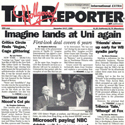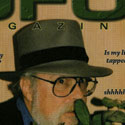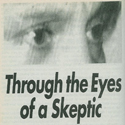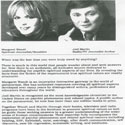

You will need to have Adobe Acrobat Reader installed to view the UFO articles. Download it from here.
Articles
Dreams and disaster happening at the same time.

Dr. Antonio de Nicolas' brother has just been elected the 30th Superior General of the Society of Jesus! History is made! Click here.
New superior urges Jesuits to strengthen service to poor. Click Here
Province Express - Father Adolfo Nicol�s. Click Here
- Is a New Eugenics Afoot? by Garland E. Allen
- The 1929 Arab Terror Attack: When Hebron Became Occupied Territory by Sammy Benoit
- "Saturn enters Libra"
- 'I am sorry,' Cardinal Mahony says amid new priest abuse details
- 04/07/08 We are all African
- 04/23/08 Moody's Blues
- 05/06/08 Lunacy and Freedom
- 05/10/08 It's not easy being Green, or even truthful it would seem
- 05/21/08 Shareholder Value
- 05/26/08 Senator Clinton, Fear, and Assassination
- 06/02/08 The Lesson Derived From Derivatives
- 06/12/08 The Price of Ice Cream
- 06/23/08 The Market
- 06/25/08 Getting Hit By A Bus
- 07/11/08 Being Right
- 07/18/08 Einstein
- 07/18/08 Karma
- 07/21/08 Ecology, Security and Economics
- 08/01/08 Who We Have Been Waiting For
- 08/11/08 From The Head To The Heart
- 08/20/08 Incarceration
- 08/28/08 Frick and Frack
- 09/10/08 Worrying
- 09/17/08 Taxpayer Bailout
- 10/16/08 Deleveraging
- 11/23/08 Too Big to Survive
- 11/24/08 Getting Hit By a Bus
- 2014: Sag New Moon --Change that perspective-NOW!
- 2024 Capricorn New Moon: Let's Get Your Cap On!
- 2nd Aquarius New Moon: 2015
- ACE OF CUPS
- ACE OF PENTACLES
- ACE-OF-SWORDS
- ACE-OF-WANDS
- After Lehman
- Amazing New Video -- The 2012 Enigma! by David Wilcock
- An Extraordinary Astrological Recapitulation by Brian McNaughton
- And now it is the Second Cancer New Moon!
- Aqaurius New Moon 2011--The New Quilting BEE!
- Aquarius New Moon 2010! It is a strange trip
- Aquarius New Moon 2012!
- Aquarius New Moon 2014 - You LikeMind me.
- Aquarius New Moon 2015 - The Zero One
- Aquarius New Moon 2016: Get Your Tribe On
- Aquarius New Moon 2017: Out of the chaos we find our Peeps.
- aquarius New Moon 2017: Out of the chaos we find our Peeps.
- Aquarius New Moon 2017: Out of The Chaos We Find our Peeps!!
- Aquarius New Moon 2018: Friends & Communities
- Aquarius New Moon 2019: No Time or Place for Emotions
- Aquarius New Moon 2020: Expect the Unexpected
- Aquarius New Moon 2021 Your Place in the Community
- Aquarius New Moon 2022: Loneliness or Circles? Your choice!
- Aquarius New Moon 2023: Wear Your Weird
- Aquarius New Moon 2024: Pluto is Getting Our Attention
- Aquarius New Moon 2025
- Aquarius New Moon--Unique Solutions if you are willing
- ARCHANGEL MICAHEL: SOUL'S JOURNEY
- ARCHANGEL MICHAEL: FAMILY AND FRIENDS
- Archangel Michael: INTENTIONS
- ARCHANGEL URIEL: STRESS
- Archangels: Stress
- Aries New Moon #1 March 2023
- Aries New Moon #2 - April 19th 2023 PDT
- Aries New Moon - It will be a great Treasure Map time!
- Aries New Moon 2009---IT’S A BIG ONE!
- Aries New Moon 2010--Let's get this party started!
- Aries New Moon 2012: You rule!
- Aries New Moon 2014 Get out of the way! Your Life is Coming
- Aries New Moon 2016: Light this rocket!
- Aries New Moon 2017
- Aries New Moon 2018: What Are Your Instincts Telling You?
- Aries New Moon 2019: Patience. Yes. That Word.
- Aries New Moon 2020: Survival
- Aries New Moon 2021: Heart Driven Changes
- Aries New Moon 2022: Finding Self Now!
- Aries New Moon 2024 Total Solar Eclipse - Wow.
- Aries New Moon 2025: A New Beginning for All
- Aries New Moon! (2008) by Tracy Cook
- Aries New Moon, 2011- Yes it is a big one!
- Article by Jock Brocas
- Back on Uncle Sam's Plantation
- Being Frugal and Benefiting
- Biomass-Eating Military Robot Is a Vegetarian, Company Says
- Bob Dylan: Like a Complete Unknown by Ron Radosh
- Books mentioned in Brian Hurst's broadcasts
- Britain Hired Astrologer to Fight Hitler
- Buddhism and the End of Economic Growth by John Stanley & David Loy
- Cancer Eclipse & New Moon 2019: Your Emotions Will Guide You
- Cancer New Moon & The Grand Cross
- Cancer New Moon --The Great Healing by Tracy Cook
- Cancer New Moon 2010---Your feelings have answers
- Cancer New Moon 2012 - "It's the flow, Baby!"
- Cancer New Moon 2014: REFRESH!
- Cancer New Moon 2016: Let It Flow
- Cancer New Moon 2017: Are your emotions flowing? Good.
- Cancer New Moon 2023: Ride the Rapids
- Cancer New Moon 2024: Emotions, Feelings and Needs- Oh, My!
- Cancer New Moon Solar Eclipse June 20, 2020
- Cancer New Moon--The first of two (2009)
- Cancer New Moon-Ready, Set, Emote! July, 14th 2007 by Tracy Cook
- Cancer New Moon: 2013
- Cancer New Moon: 2022 - Emotions Guide Us To Our Heart
- Cancer New Moon: Don't make me go find your roots...you do it!
- Cancer New Moon: Feelings. Emotions. Passion. 2021
- Cancer Solar Eclipse 2018
- Capricorn 2010 NEW MOON--Taking Care of Business!
- Capricorn 2011-Aim your ambition-NOW
- Capricorn New Moon - Get Serious!
- Capricorn New Moon 2011 -Be the authority and move up!
- Capricorn New Moon 2013: Pragmatic and no excuses
- Capricorn New Moon 2014
- Capricorn NEW MOON 2016 ...Get Real!
- Capricorn New Moon 2018
- Capricorn New Moon 2019 - Pragmatism Pragmatism Pragmatism
- Capricorn New Moon 2019: Focused and Disciplined
- Capricorn New Moon 2019: Focused and Disciplined
- Capricorn New Moon 2021. Climb Like a Goat
- Capricorn New Moon 2022: Climb Heights
- Capricorn New Moon 2025 Ambition for You
- Capricorn New Moon Dec 2022: CEO of Values
- Capricorn New Moon: Slow and sensible is a-okay.
- Children Skipping Childhood
- Clean your Slate Capricorn New Moon! by Tracy Cook
- Compliments Do You Get Enough Of Them?
- David Kaiser from MIT, not David Kaiser from the Naval War College
- Detach From Rescuing
- Did Yale prostitute itself for oil money? by Ethel C. Fenig
- Do I Remember Differently Than Another Does?
- Do you feel good about where you live? by Jill Saint James
- Dreaming on Pisces New Moon by Tracy Cook
- ECSTASY
- Energetic Health Food By Eva Sanchez,N.D.
- Face The Music
- Fox Blowviator Bill O'Reilly wants you to hate him
- GEMINI NEW MOON 2011 –“Can someone turn on the air, please?”
- Gemini Eclipse New Moon 2021: Fact versus Fiction and Pivot !
- Gemini New Moon (2012)- Second time's the charm
- Gemini New Moon 2009---The Fast and Furious Talker
- Gemini New Moon 2010: A Tornado among us!
- Gemini New Moon 2013
- Gemini New Moon 2014: The power of light feet
- Gemini New Moon 2014: The power of light feet
- Gemini New Moon 2018 - Thoughts!
- Gemini New Moon 2019: Mix it up & Adapt
- Gemini New Moon 2020: Reboot Your Inner Computer
- Gemini New Moon 2022: Process the Information
- Gemini New Moon 2023: Fuzzy Data But Still Informs
- Gemini New Moon 2024: Cha-Cha-Cha-ing
- Gemini New Moon by Tracy Cook
- Gemini New Moon-- Reach out! Mix it Up!
- Gemini New Moon--the first round- 2012
- Gemini New Moon. Mental Exercises 2015
- Gemini New Moon. Mental Exercises 2015
- Gemini New Moon: Question and Shift
- Gemini- New Moon 2008-- Ready to Connect! by Tracy Cook
- Get out of the way---LEO NEW MOON is HERE!
- Get your Viking on--Aries New Moon 2013
- Getting the Scoop by Janet Donovan
- Glossary of Number Values
- God + Faith by Margaret Wendt
- God Heard The Need
- Headaches are Telling You Something by Eva Sanchez, N.D.
- Heart Ethics by Way of Introduction by Dr. Antonio T. de Nicolas, PHD
- Hi Ho Silver!!
- History Unfolding by David Kaiser
- How American corporate philanthropies launched a national campaign of ethnic cleansing in the United States, helped found and fund the Nazi eugenics of Hitler and Mengele — and then created the modern movement of "human genetics." by Edwin Black
- How to sit with a medium
- I Forgot To Accept The Things I Can Not Change
- I Want Your Help, I’m An Atheist
- In a generation or two, the US will ask itself: "Who lost Europe?"
- In fallout from crisis, rethinking risk and human judgment by Lynnley Browning
- Incredible information and facts about the paranormal and publishing
- Is A Shift Needed in Parenting Values?
- Is Your Community Antisocial?
- It is all a balancing act, Baby! Libra new moon 2008
- Jess Stearn
- JFK Junior - John Jr. by Sloan Bella
- Jon Bennett Ramsey by Sloan Bella
- Keeping a Tally Sheet
- Kurt Cobain - Celebrity Channel by Sloan Bella
- Learn about Boundaries
- Lemon for Lymph By Eva Sanchez N.D.
- LEO 2008 New Moon--Sunny side of the street by Tracy Cook
- Leo New Moon - Round two & Solar Eclipse 2017
- Leo New Moon - The First One! 2017
- Leo New Moon - The First One! 2017
- Leo New Moon - To be bold or not to be bold? That is the question
- Leo New Moon 2011--Your passion tells you so
- Leo New Moon 2012--The Heart Wants To Thrive
- Leo New Moon 2013: Be Big. Be Very Big
- Leo New Moon 2015: Learn from the Lion!
- LEO NEW MOON 2016: Dare to find Joy & Strength
- Leo New Moon 2019: Be Special, dang it!
- Leo New Moon 2020: Put on Your Sloppy Cape
- Leo New Moon 2023 - 29 Days of Brave
- Leo New Moon 2024: Love, Strength and Courage
- Leo New Moon Eclipse 2018
- Leo New Moon: 2021 - Find Your Authentic Heart
- leo New Moon: 2021 - Find Your Authentic Heart
- Leo New Moon: 2022 - Be YOU.
- Leo's in the House..Roar! Sort of.. by Tracy Cook
- Libra New Moon (2007) by Tracy Cook
- Libra New Moon -How do you relate? Does it serve you?
- Libra New Moon 2009--The business of relating
- Libra New Moon 2012-
- Libra New Moon 2013 -- Balance That!
- Libra New Moon 2014: Let's really get our Libra on this time
- Libra New Moon 2015: Get your relationships straightened out
- Libra New Moon 2016: The Power of Negotiation
- Libra New Moon 2017: Not as light as you think
- Libra New Moon 2018: Power & Negotiations & Self Worth. Repeat.
- Libra New Moon 2019: Your Identity, My Identity & An Oxygen Mask
- Libra New Moon 2020: Bumpy. Power. Kindness. Repeat.
- Libra New Moon 2021: Where's your balance?
- Libra New Moon 2022 : How are your relating skills?
- Libra New Moon Eclipse 2023
- Libra New Moon Eclipse 2024: What's That Zagging?
- Look In My Eyes
- Love in the Land of Loneliness by Joseph Dispenza
- Marilyn Monroe - June 2004 - Celebrity Channel by Sloan Bella
- MAY GOD BLESS THIS AIRLINE CAPTAIN
- Me Controlling
- Meditation: The Making of Images By Antonio T. de Nicolas, PhD
- Mindy Sommers
- Mirror Mirror On The Wall
- My Global Warming Epiphany by Randall Hoven
- Narcissistic Behavior Is Increasing
- Neediness
- Nevins Rules by Julie Salamon
- New Moon in Aquarius 2013 Pull out your lightening rod-hits are coming
- New Moon in Virgo--Now you can fix your life
- New Moon Leo 2010--Wish upon a star--"Hey, that's me!"
- No One Mention The War!
- Pass The Buck
- Patience is a Virtue
- Pisces 2021 New Moon - All We Need is Love
- Pisces New Moon 2010--The LEAP of FAITH
- Pisces New Moon 2012: What is Dissolving?
- Pisces New Moon 2013 -Get in the flow
- Pisces New Moon 2014: Go for the Flow
- Pisces New Moon 2015
- Pisces New Moon 2016: Karma and Elevation
- Pisces New Moon 2017 -- The Big Release and Melt
- Pisces New Moon 2018: Intuition Speaks Are You Hearing It?
- Pisces New Moon 2019: Dazed and Confused --Thank You For It
- Pisces New Moon 2020: Time to Get Quiet
- Pisces New Moon 2022: Finding the Inner World
- Pisces New Moon 2023: Beep!
- Pisces New Moon 2024: Connecting to Bigger
- Pisces New Moon 2025: Unplug and Replenish
- Pisces New Moon---Mystics Apply
- Pisces New Moon--Dive or wash up on shore, it is your choice!
- Private Space Is Healing
- Psychic portraits of the Bangs Sisters
- Psychics, Mediums, and Rock N Roll
- Raymond Moody
- Re-wounding
- Re: Mars turns retrograde as Jupiter conjuncts Neptune on the Winter Solstice
- Re: Planetary Forecasting Methods for Traders
- Re: Saturn turns retrograde; Solar Eclipse; Mercury turns direct; Jupiter enters Pisces
- RESPOND TO RESPONSIBILTY-CAPRICORN NEW MOON 2008
- Responsibility Came From Being Told No
- Robert Monroe
- Sag New Moon 2010-- Ready, Aim---Change!
- Sag New Moon 2012 - A time to get real
- Sag New Moon 2021 Total Eclipse
- Sag New Moon 2023: Bits of Joy is still Joy
- Sag New Moon Total Eclipse 2020: The Truth is in The Mirror
- Sag New Moon---All Vision without the Hype!
- Sagittarius New Moon 2009--Ready, Aim, Adjust...Fire, Adjust, Aim, Ready..
- Sagittarius New Moon 2013 - Forward Ho!
- Sagittarius New Moon 2015: The Adventure!
- Sagittarius New Moon 2016: Get Wise Get Inspired
- Sagittarius New Moon 2017 - On Top of The Galactic Center
- Sagittarius New Moon 2018 - Get Inspired. Now!
- Sagittarius New Moon 2019: Hot & Cold Wisdom
- Sagittarius New Moon 2024: Finding The Way
- Sagittarius New Moon--Mother Knows Best
- Scorpio New Moon (2017) : Act Like a Plumber!!
- Scorpio New MOON 2009-Resources and Community--Where do I fit?
- Scorpio New Moon 2010-Jump in the water!
- Scorpio New moon 2012: Suit up and Commit
- Scorpio New Moon 2015
- Scorpio New Moon 2016: Release the death grip
- Scorpio New Moon 2018 - Rejuvenate!
- Scorpio New Moon 2019 - Shocked to Vulnerability
- Scorpio New Moon 2020: Dig Deep & Get Rid of Debris
- Scorpio New Moon 2023: Depth & Release
- Scorpio New Moon 2024: Tapping Power & Getting Unstuck
- Scorpio NEW MOON by Tracy Cook
- Scorpio New Moon Solar Eclipse SHED! SHED!SHED!
- Scorpio New Moon(2011)--DNA, Survival and ditching Garbage
- Scorpio New Moon: Get Your Plumbers Butt On!
- scorpio New Moon: Get your Plumbers Butt on!
- Scorpio New Moon: Solar Eclipse 2014
- scorpio New Moon: Solar Eclipse 2015
- Scorpio Solar Eclipse New Moon 2022: Release. Got it?
- Second Cancer New Moon 2020
- Sharia rejects all fundamental premises
- Speaking From Experience
- Speech by Lou Pritchett
- SURE RELATIONSHIPS BITE--BUT WE'RE ALL HUNGRY. Libra New Moon 2010
- Taurus New Moon 2008!
- Taurus New Moon 2010-----And so we begin.......
- Taurus New Moon 2011--Build upon it!
- TAURUS NEW MOON 2012 --What do you value?
- Taurus New Moon 2017: Practicality for a Personal Revolution
- Taurus New Moon 2018: Making Changes Bit by Bit
- Taurus New Moon 2019: Feel The Changes
- Taurus New Moon 2020: The rest of the year and being practical
- Taurus New Moon 2021. Slow down and find your values.
- Taurus New Moon 2022: Our Resources, our Love our Values!
- Taurus New Moon 2024: The Power of Slowing Down
- Taurus New Moon Eclipse: Yes you can make the changes!
- Taurus New Moon. Getting Practical ..Seriously, for real
- Taurus New Moon: May 19 The Glory of Practicality!
- Taurus New Moon: 2025 - Finding Stability In Extraordinary Times
- Taurus New Moon: Take the short route between A&B
- Taurus to the RESCUE!
- TaurusNewMoon 2014--Building Good bit by bit
- The Alinskyite's Big, Fat Governance Failure by Kyle-Anne Shiver
- The collapse of the U.S. Dollar and Federal Reserve? by Ted Phillips
- The coming collapse of the U.S. Dollar and Federal Reserve?
- The Consoling Angel by Antonio de Nicolas
- THE EMPEROR
- THE EMPRESS
- THE FOOL- MAJOR ARCANA
- The Ghosts on Moaning Mountain
- THE HEIROPHANT
- THE HIGH PRIESTESS
- The Horrifying American Roots of Nazi Eugenics by Edwin Black
- THE MAGICIAN- MAJOR ARCANA
- The Most Important Astrological Chart for Your Financial Security
- The Nightmare of Rationing in Oregon by Jeff Emanuel
- The Price of Ice Cream by Bill Sharon
- The Promise of the Past by Betty J. Kovács, Ph.D.
- The Reincarnation of Edgar Cayce and His Soul Group? - You Decide.
- The Sea has changed---SCORPIO NEW MOON 2008
- The Shadow and Karma
- The Spiritual Candle
- The Thieves of Happiness
- There she blows!!! SAG NEW MOON is HERE! by Tracy Cook
- Thomas Edison's Paranormal Personality by Margaret Wendt
- Thomas J. Curry must Leave Santa Barbara
- Tick Tock Virgo New Moon Strikes the Clock....2008
- Time To Connect With Like Minds
- Too Much Of A Good Thing....Is It Really Wonderful?
- Treasure Mapping by Tracy Cook
- Verbal Abuse Hurts
- Virgo 2018 New Moon - A Hero's Journey
- Virgo 2019 New Moon - A Car Full of Nerves
- Virgo New Moon - Your daily life is YOU. How is it going?
- VIRGO NEW MOON --GET YOUR MICRO ON!
- Virgo New Moon 2011- Help & Work serve you!
- Virgo New Moon 2012: Sweating the Small Stuff
- Virgo New Moon 2013: A Big Opportunity
- Virgo New Moon 2016 - What's that stuff in your schedule?
- Virgo New Moon 2017: Skills Needed! Please Apply
- Virgo New Moon 2021: Daily efforts build your life
- Virgo New Moon 2022: Don't be a burnt out Roomba
- Virgo New Moon 2023: Keep Your Head Down & Do The Work
- Virgo New Moon by Tracy Cook
- Virgo New Moon--Details Rule
- Virgo New Moon: 2020 - Every choice is yours
- Virgo New Moon: 2024 - Control Your Future By Your Schedule
- Vowels by Jill Saint James
- What Does Cutting Back On Expenses Mean To You?
- What Is A Distraction?
- What To Do This Taurus New Moon by Tracy Cook
- Where have all of the leaders gone? by Lee Iacocca
- Who Has Time To Read?
- You Feel Their Pain
- You had me at Hello, Aquarius New Moon by Tracy Cook
- You Lose Out When You Judge a Book by Its Cover
- You Make The Choice I Don't Care
- ‘Transce-end’ the trance – Bring out your dead!
- Uri Geller
- Margaret and Joel
- Houdini
Letters Sent to Us from the Public
- The 1929 Arab Terror Attack: When Hebron Became Occupied Territory by Sammy Benoit
- Biomass-Eating Military Robot Is a Vegetarian, Company Says
- Bob Dylan: Like a Complete Unknown by Ron Radosh
- Buddhism and the End of Economic Growth by John Stanley & David Loy
- David Kaiser from MIT, not David Kaiser from the Naval War College
- Did Yale prostitute itself for oil money? by Ethel C. Fenig
- History Unfolding by David Kaiser
- My Global Warming Epiphany by Randall Hoven
- The Alinskyite's Big, Fat Governance Failure by Kyle-Anne Shiver
- The collapse of the U.S. Dollar and Federal Reserve? by Ted Phillips
- The Nightmare of Rationing in Oregon by Jeff Emanuel
- Where have all of the leaders gone? by Lee Iacocca
Articles by Joel Martin
- Through the Eyes of a Skeptic
- Question and Answers
- Who Believes in the Paranormal?
- Nancy Reagan
- Ghost Ship
- I'm gonna get you 'suckers'
- Margaret Wendt and Joel Martin's New Book
Articles by Margaret Wendt
Paper Media: click thumb (where applicable) for full size image/.pdf files

Margaret's Magazine 1
Margaret's Magazine 2
Margaret's Magazine 3
Margaret's Magazine 4
Margaret's Magazine 5
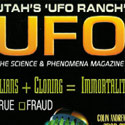
News Anchor's
UFO experience
My Favorite Martian
Article by M. Wendt
Robert Urich
Spirit Magazine
The Healers Magazine
Entertainment Tonight
Magazine for Cleveland
- News Anchor's UFO Experience by Margaret Wendt
- My Favorite Martian by Margaret Wendt
- Looking for Love by Margaret Wendt
- God + Faith by Margaret Wendt
- Thoms Edison's Paranormal Personality by Margaret Wendt
- Margaret and Joel
- Who was Hayim Solomon?
- Nevins Rules by Julie Salamon
- Psychic portraits of the Bangs Sisters
- Psychics, Mediums, and Rock N Roll
- The Ghosts on Moaning Mountain
- The Spiritual Candle
- Thomas Edison's Paranormal Personality by Margaret Wendt
- Margaret Wendt and Joel Martin's New Book
Meditation: The Making of Images By Antonio T. de Nicolas, PhD
Introduction
From the Rig Veda to Plato the act of imagining is the secret technology of the mystics. While most people use fantasy to achieve the results they fantasize for the sake of the subject, and theologians use concepts to claim knowledge and revelation, imagining has been always the technology of a few souls, from East and West, in their effort to repeat the divine act of creation uncontaminated by human faculties. For this reason and to describe what this technology is based on I have chosen to write this paper following the clear descriptions of this act as found in the writings of Ignatius de Loyola and as he used them in the making of his Spiritual Exercises. The reason for this choice is the radical need of presenting how images are made, rather than borrowed in meditation. It is my contention that this tradition of making images in meditation is present wherever meditation is practiced. It is common in Hinduism, from the Rig Veda down, in Buddhism, and in Christianity, as well as in other religions. The aim of such presentation is to show that in religious practice no image may be borrowed.
Meditation
Ignatius is convinced that meditation is the road to that inner space that may be revealed, opened, touched, uncovered by that unique act of creation, unique to meditation, and by no other creature, object or sensation. Only God, he believes, owns the human center (Exer. 316, 322, 329, 330).But this center is covered by a communications system, a natural attitude, a self indulgence, that impedes human access to it. Ignatius' initiation into this mystery is a definite effort at breaking down this communication system and building a new one through which the soul and God may communicate. Since the external communications system has also, through language and its repetition, through the use of the faculties and the repetition of this use, sensitized the subject into a series of body sensations and their habitual comfort, the new system of communications will aim precisely at destroying, suspending, this habituation. The exercises start in the human body and end in the transformation of this same human body. The body is the primary text and primary technology, while the discourse about the experience is the "secondary text" and "secondary technology." Through the exercises a new language is given the retreatant, a new memory and a new imagination. Through this retraining a new will might emerge in harmony with the Will of God.
Language and the Will
The first week of the exercises is one of trial and training. It is a time of testing the will of the retreatant and the body of that will. Not everyone's body is ready for meditation at the particular time chosen for the exercises. Ignatius wants to single out those who might continue and those who should proceed no further. Though the exercises carry so much promise they could also be dangerous to one's health if not done under the best physical conditions. Ignatius says of "those with poco suiecto (little temperament, lack of stamina and preparation) that "they should not proceed any further" (Exer. 18).
This first week is one of violence to the body habits of the retreatant. He is asked to search for a "place" (Exer. 20) away from the ordinary place to which he/she is normally accustomed: the cave of Manresa, a lonely room, a different room from the one usually inhabited, a different house, a monastery in the country, an unaccustomed place, a place where the retreatant has to invent new body habits and where outside communications systems do not reach. The retreatant is also instructed about lights: less in the first and third weeks, more in the second and fourth (Exer. 79). The retreatant's body is subjected to new and calculated positions: kneeling, prostrating oneself face down, standing with the head bent down, pacing, walking, sitting rigidly (Exer. 74, 75, 76, 77) lowering the eyes, raising the eyes, closing out sounds, listening to special rhythms as the meditation dictates (Exer. 81, 258). The whole body of the retreatant must be reeducated until it becomes like a repellent to the external communications system and habits he/she was familiar with. All gestures, facial expressions, bodily movements, bodily expression must be painstakingly gone over as if in slow motion so that the body becomes impervious to the outside and begins to learn the technologies of facing and gathering within.
The will of the retreatant is now used as a surgical knife to cut some openings into the interior world. The whole attention of the retreatant is now away from the outer world even if in order to achieve this he/she must cut to pieces, one by one, the different lived moments of his/her life, the different moments of a day, of a prayer, of a meditation, of an examination of conscience, of an act, a look, a thought (Exer. 24, 25, 26, 27, 33, 34, 38, 42, 43). But on the trail of these acts of the will a language is being formed: "intense pain and tears," ugliness and evil...of sin" (Exer. 57), compare God's attributes to yours, wisdom and ignorance, omnipotence and weakness, justice and inequity, goodness and selfishness (Exer. 59), "esclamacion admirative con crescido afecto" (shout with amazement and filled with a growing emotion) (Exer. 60); self-pity, gratitude, amazement, disgust, consolation, desolation (Exer. 62) are the signs of this language the will has started to create by turning the entire life and every minute of it into an interior timetable where only the chimes of eternity are heard. By the time the will becomes habituated to those exercises there will no longer be room for external and familiar languages. The clock of the "solitary region" is now running. The interior timetable now determines one's waking (Exer. 74), the kind of prayer, examinations of conscience (Exer. 43) and meditations one makes and what conversations one will bring to the guide of the exercise. The prayer may take various forms; it may be light and relax the emotions (Exer. 238), or it may focus on the seven deadly sins (Exer. 244), or on the three powers of the soul (Exer. 246). It may become a meditation which considers every word pronounced (Exer. 249), or which concentrates only on those points of meditation "where I felt the most intense spiritual feeling" (Exer. 62). And, of course, we must not forget, a new diet has to be included (Exer. 84), and one should sleep with less comfort than one is used to and cause sensible pain to the body (Exer. 85). Even while going to sleep there is no stopping this clock; one should prepare oneself for the coming day by going over the memory-points of the meditation one is going to make in the morning (Exer. 73). Upon awakening, one should bring to mind what one is about to meditate on. The clock of the "solitary region" does not allow any external language to come in; there are no cracks between exercises: "no dando lugar a unos pensamientos ni a otros" (not to make room for this kind of thoughts or any other) (Exer. 74).
Spiritual exercises, however, do not compare to any army "boot camp." Ignatius is very sensitive to that: "If the one giving the exercises sees that he who makes them is in desolation or temptation, he should not be harsh or severe with him, but rather gentle and soft..." (Exer.17). And if at times Ignatius recommends acting against natural inclinations (agere contra, do the opposite Exer. 13, 16), as when one feels like not going the length of a whole hour in meditation, one should therefore at once decide to go for one hour and a half. He also makes the exercitant aware that all those things he/she is trained to do are only means to an end. One should use, therefore, those things only "tanto... cuanto" (as much as) (Exer. 23) one needs to in order to achieve those ends. For in the end the exercises are for the soul to get ready to receive the Will of God, not suggestions from the guide of the exercises, or confessors, or friends, or enemies: ...it is much better, in searching for the divine Will, to let Our Creator and Lord communicate Himself to the devoted soul..." (Exer.15).
The exercises of the will and the hint of the language that emerges builds around the inner space of the retreatant a scaffolding of inner habits ready to sustain the new emerging body of meditation. But then the drama unfolds. While the retreatant experiences the excitement of the new, he/she also experiences the bereavement of the familiar. The retreatant is not guaranteed that the divinity may enter the solitary space, while the familiar will no longer feel the same. The retreatant can never anticipate what is about to happen or even if it will happen. One needs to give up everything and, yet, one cannot anticipate that the empty spaces are going to be filled. This journey needs raw human faith, the exercises themselves that keep opening horizons of language, and memory along with its predictability. The exercise now is memory.
Memory and Predictability
The origin of Christianity was an experience that had already happened. It originated outside of time with the Trinity and entered time in the Second Person of the Trinity through the mysteries of the Incarnation and Redemption. It is precisely because of the fact that this experience has already happened that for every. Christian to know is to remember. Memory makes of Christians communities and religion; it is the common ground of memories, on which all stand, that joins them as community. Without memory Christianity could not be articulated. Christ had already set down the internal law of the community: "Do this in remembrance of me." (Luke 22, 19) And even when the Father will send, in Christ's name, the Comforter, the Spirit, He will do it to "bring all things to your remembrance" (John 14, 25). To be a Christian is primarily to live on memory, to turn memory around, to store memories, to turn every sign, whatever its origin, into a memory-point, to articulate those memories so that memory remains active. Those memories are the remembrance of the Will of God in operation. They are the memory of a past actively present and therefore, being God's Will, with a future. It is a memory that predictably organizes the future. But not without human effort and participation. Strictly speaking, the Spiritual Exercises are a string of memories, of memory-points. Even the exercises as written are not to be read for information or edification or content. Each and every word is slowly and carefully chiseled out so that it becomes a memory-point for action, or for making memory.
The journey of the retreatant's will dividing his/her life into the search for sins, the day divided into exercises of the will to discover flaws, to remove flaws, these exercises are primarily exercises in memory: memories that travel back and forth, up and down, within the perimeters of a human life. Meditation begins by "bringing to memory" the first sin of the angels (Exer. 50); "by bringing to memory" the sin of Adam and Eve (Exer. 51); "by bringing to memory" our sins (Exer. 52), all the sins of my lifetime (Exer. 56), year by year, place by place, looking at the places I have lived, conversations I have had, work done (Exer. ibid.); bring to memory to instruct the intellect in it: "so that the intellect, without meandering, may reason with concentration going over the reminiscences (memories) of the things contemplated in past exercises..." (Exer. 64). Ignatius literally means, through the Exercises, "to bring all things into remembrance." In order to bring all things into remembrance, however, demands from us certain shifts in technologies. In every case human effort is needed.
Ignatius de Loyola shared with the other mystics of his time habits of reading different from ours. Early in his Autobiography (Autobiography 6 and 7) he lets us know how he used reading in order to fix memory points and visualize the things the Saints did and that he could also do. With these memories he would then dream of doing greater things for the service of God. In this manner Ignatius kept his mind well occupied. Ignatius' knowledge came through the experience of meditation, not through reasoning out the mysteries of Christianity. It is true that the Exercises use the three potencies or faculties of the soul, but it is through memory that they are held together, or by turning all things into remembrance. The flight of the soul will eventually take place through imagining.
Turning all things into remembrance is not an easy task, however. The memories of Christianity are not factual history, are not deeds humans caused on humans or nature. In order to turn all things into remembrance one must perform a radical hermeneutical act. How does one remember "the souls in hell" or the Trinity before Creation, or angels sinning, or how Christ used his five senses, or even one's own sins without a radical reinterpretation of those cognitive ciphers in view of the experience that already happened? Those are living memories to a Christian and therefore recoverable. To recall them is to call them, and therefore, they may be articulated in language. They are the language in which imagining takes place. On these memory units imagining will act. This memory bank is the only security the retreatant has that the system works; it is the language of Christianity, its communications system. It is in this sense, of memory in use, that memory acts with an element of predictability in the system. Memory, by turning back, vivifies the retreatant and guarantees the future. Memory mediates all human action: it is language and it is divine human life.
Imagining as Individual Dismemberment
Language, in order not to be a dead language, must be used, spoken, written down. Memories would become dead if not activated through acts of imagining.
Contrary to contemporary practices in psychology, where imagining is guided so that individuals and groups share the same image and are guided in imagining it, or where archetypal images are the object, goal, and the identity of imagining, Ignatius, astonishingly enough, leaves the retreatant entirely to his/her "own abilities" (Exer.18) when guiding him/her in the act of imagining. Ignatius provides memory points, describes how to imagine, but the images of imagining are absent from the Exercises . Actual imagining is the retreatant's exercise. This may be understood because Ignatius cannot draw on any existing reservoir of images in order to correct mistaken identities. He cannot draw from any subjective field of images with which the subject may be more or less familiar, because through some of those images individuals have already experienced transformations, even creations. Ignatius displaces the retreatant from any subjective or objective pools of images and vigorously transplants him/her to an imageless field where the absence of images will force the exercise of creating them. This kind of imagining is the more powerful because it does not rest on images anyone ever before created. Neither the exercitant nor the world has the images of the exercises of imagining. The images to be born are of a sheer power of imagining which includes not only the act of imagining, but the act of creating the images.
This strategy of Ignatius is so demanding that it rests more on the actual technologies of imagining than on any images. Thus his insistence on the technology of concentration in order to bring out the pure image, the uncontaminated image, the image in perfect solitude, the original image, the divine image. The image created in meditation is the only image that will gain currency in meditation. One cannot borrow it, one must create it. In this creation all other images are automatically excluded. The whole technology developed in the Exercises has one aim: the perfect image, for it is in it and through it that God's signs will appear. The image will turn to language and return to the public domain.
The pure image, the original image, will penetrate the public domain if first it penetrates the material body of the retreatant. This material body is always set facing the scene, the image, to be imagined. But this material body is a fluid body through imagining: a slave in the Nativity, a knight in the Two Kingdoms, a sinner facing the Cross; or it may change sizes if compared to other men, the angels, God (Exer. 58); it may become a vermin worth "many hells" (Exer. 60); or the temple, image of God, animated by God, sensitized by Him (Exer. 235).
Technically, however, this material fluid body of the retreatant, becomes dismembered through the act of imagining. Ignatius conceives imagining as an act of dismembering the senses by running them in isolation, one by one, through the image being made.
The retreatant is placed in front of a scene and asked to make his/her own "contemplacion viendo el lugar" (contemplation seeing the place). With exhausting detail, he/she is asked to make up the scene; the road: how long, wide, flat running through valleys or hills; the cave: how big, small, how high, how low, how furnished (Exer.112). Imagine hell, the width and depth and length (Exer. 65), or imagine the synagogue, villages and castles (Exer. 91), or the Three Divine Persons (Exer.102), or Mary riding a donkey or Joseph pulling an ox (Exer.110). But for Ignatius the image alone is not the source of signs. The image on recall is to call it to memory. The actual birth of the signs or the system of signs does not take place until the retreatant proceeds, through imagining, to "read" the image through his own dismembered sensorium. The perfect image, the solitary image, the divine image is set into motion through the sensuous motion of the retreatant's senses as he or she runs them, one at a time, through the image. It takes the "reading" of the image by each sense so that it becomes a mediation of signs. The efficacy of the image is made possible on condition that the subject be kept elusively absent, as a fixed unity, in the act of imagining. What he or she is asked to do instead is to lend sight, sound, smell, touch, movement to the image. The image must be filled through the reading of each sense on the image. He or she vitalizes the image through his or her dismembered sensorium. Each sense must read the image separately; each sense must sensitize the image separately; each sense must read/write its separate movement on the image separately. What is done through visualization must be repeated through hearing, smelling, touching, moving. This applies to the exercises on hell, the Nativity, the Cross, Resurrection, in short, to any exercises where images are to be imagined.
It is the exercise of imagining that makes the appearance of signs and the articulation of both as a language possible. Images of themselves, do nothing. The retreatant must exercise them by reading/writing sensation on them. In its preparatory stage imagining is a technology that if performed in all its purity will return signs and articulate itself into a language. It will also force the sensible signs to appear in the act of sensitizing the image of meditation. As a consequence and because it is an embodied technology, it will also desensitize the subjects to their original unities and attachments while sensitizing them to the new and fresh sensations. Imagining, therefore, with its preliminary organization of daily acts, memories and sensitizing of images, is the primary technology through which a language/text appears and may be articulated. Without this primary text written in the human body, this technology of habituation, signs will not appear nor the language of their articulation. The primary technology thus is the causal origin of the signs, the diacritical systems of signs, that are to be read. The reading of those signs will have several readers: the retreatant, his director or confessor, his spiritual guide, whoever is trained to read such a text. The reader must know the primary technology and the primary text and be an expert in reading the signs. He/she must be able to read them even if he/she is not the author of the primary text or the reader/writer of the primary technology. It is on this condition that the primary text and primary technology produce not only a language but also the possibility of its articulation, either as a private articulation to a spiritual guide, or as a public articulation for the public domain.
Conclusion
Though this hermeneutical task is unfinished, it should be suggestive enough to encourage all those interested in deeper unities than theological civilities to search for a way of making possible inter-religious communities where serious, dedicated forms of meditation are made available to all.
Human technologies divide into two groups: one follows the image of the sinner-Savior model where the individual has hardly any room to do anything on his/her own, for he/she is always at the mercy of "compliance" with an ethical code dictated by this model.
On the other hand, there is the Avatara-mystical model, the individual uses technologies that infuse all his/her brains with knowledge and allows him or her to embody the human paradigm as it moves along. Heart Ethics is the guide here, and the training is geared to be able to chose from among the possible (dharma) facing you, the best, by habit, as Plato and Indic texts proposed before him and is found in the mystical literature of the Spiritual Exercises of Ignatius and other mystics.
Before Ignatius wrote his Exercises Indic Tradition had already imprinted the paradigm in the human species with the practices of the yogas of the Bhagavad Gita. Krisna moves by the neural pathways of the left brain to gain distance from Arjuna's trauma, and on to the communities of the right brain practices, embodying them as he moves to the point when in chapter eleven he shows the bewildered Arjuna his geometries without the forms Arjuna so loved or feared, or with the forms already destroyed. Kalo'smi: I am Time, Krisna proclaims, I am all a man can be, now…And so can you if you learn to make decisions. Of course, Indic Tradition does not have to deal with the sinner-Savior model for in this Tradition, from the Rig Veda down, all the gods are "this side of Creation," as the Rig Veda proclaims, and manas (the mind) is not a faculty but one more of the senses.
And so, in the end, make sure your exercises correspond to your available neural connections and brain centers, restrain your fantasy, cancel out your left brain until you leave meditation and translate whatever happened there into ordinary prose or poetry or simple power of decision making. There are two roads, make sure you find the one leading to the technologies of the heart.
Bibliography
de Nicolas, A.T. (1986) Powers of Imagining: Ignatius de
Loyola, State University of
New York Press, Albany N.Y
(1976,8,2003) Meditations Through the Rig Veda, Shambhala, Boulder- London, Nicolas-Hays, iUniverse.com.
(1990) The Bhagavad Gita, Nicolas-Hays,
(1989,1996)
(1976) Avatara: The Humanization of Philosophy.
Nicolas-Hays,
Note: Meditations and Avatara will soon be ready at iUniverse.com and on line.
Antonio T. de Nicolas was educated in
Dr. de Nicolas is the author of some twenty- seven books,
including Avatara: The Humanization of Philosophy through the Bhagavad Gita,a
classic in the field of Indic studies; and Habits of Mind, a criticism
of higher education, whose framework has recently been adopted as the
educational system for the new
A philosopher by profession, Dr. de Nicolas confesses that his most abiding philosophical concern is the act of imagining, which he has pursued in his studies of the Spanish mystics, Eastern classical texts, and most recently, in his own poetry.
His books of poetry: Remembering the God to Come, The Sea Tug Elegies, Of Angels and Women, Mostly, and Moksha Smith: Agni's Warrior-Sage. An Epic of the Immortal Fire, have received wide acclaim. Critical reviewers of these works have offered the following insights:
from, Choice: "...these poems could not have been produced by a mainstream American. They are illuminated from within by a gift, a skill, a mission...unlike the critico-prosaic American norm..."
from The Baltimore Sun: "Steeped as they are in mythology and philosophy these are not easy poems. Nor is de Nicolas an easy poet. He confronts us with the necessity to remake our lives...his poems ...show us that we are not bound by rules. Nor are we bound by mysteries. We are bound by love. And therefore, we are boundless"
from William Packard, editor of the New York Quarterly: " This is the kind of poetry that Plato was describing in his dialogues, and the kind of poetry that Nietzsche was calling for in Zarathustra."
Professor de Nicolas is presently a Director of the
Biocultural Research Institute, located in
ATTENTION!
It has been brought to our attention that Margaret is being portrayed as a psychic on $1.99 sites. These sites are doing so without Margaret's permission. Margaret has not claimed she is a psychic. - MW









